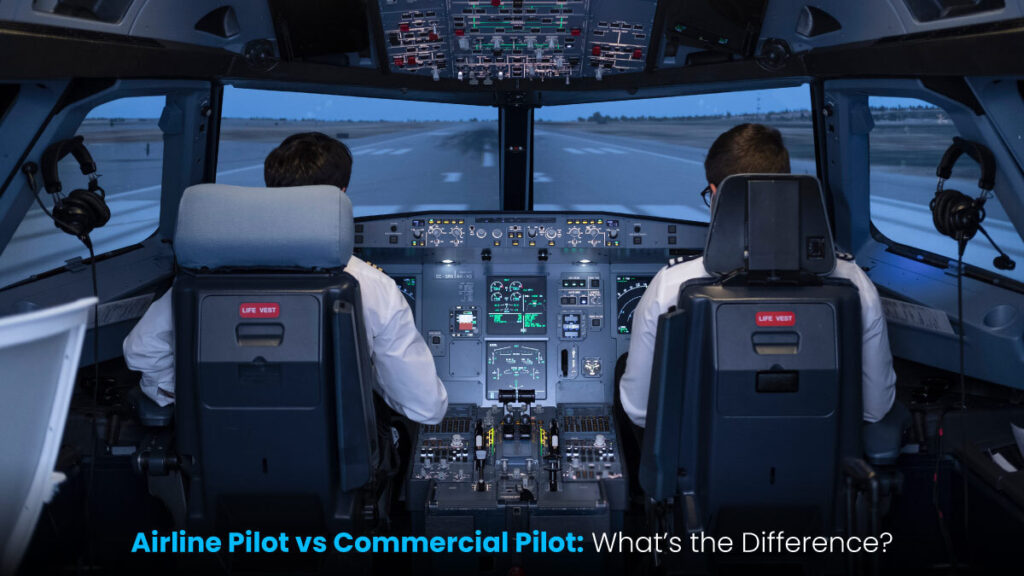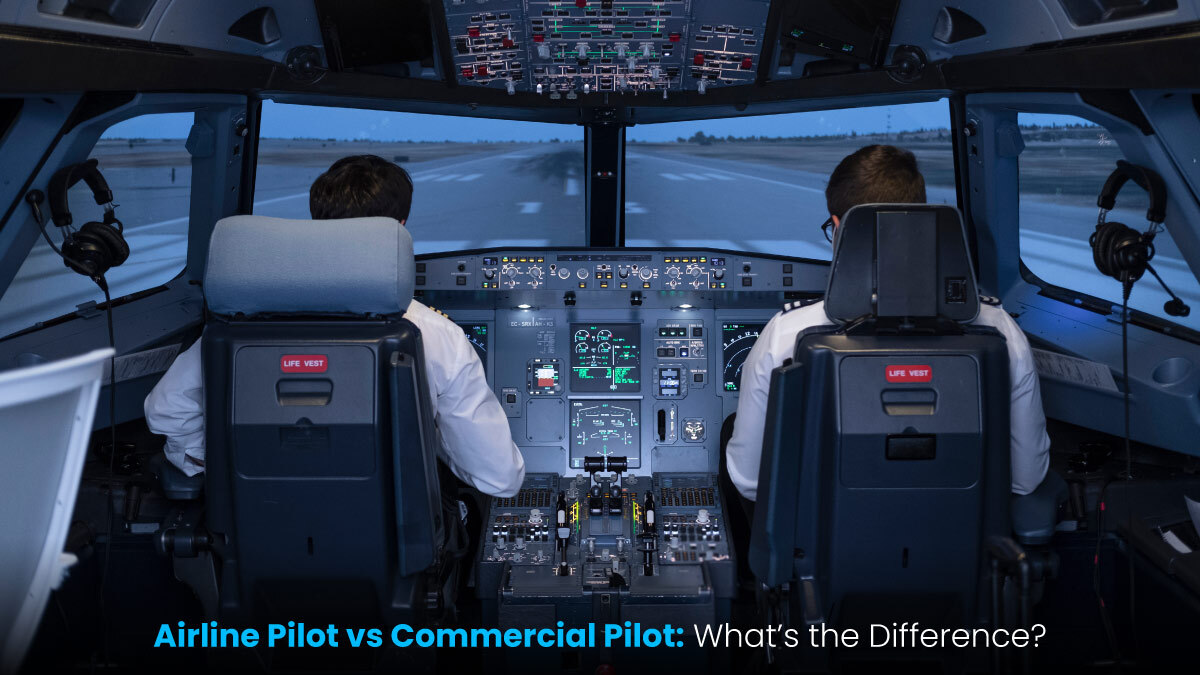
Are an Airline Pilot and a commercial pilot the same thing? A lot of people think so, but they’re actually different in important ways. Both fly planes for a living, but their training, jobs, and career goals can be very different. In this blog, we’ll explain it in a simple way to help you understand what each one does and how to choose the right path if you want to become a pilot.
Understanding the distinction is very beneficial. It helps you determine what kind of pilot you want to be, plan your training, and estimate the time and money required. Whether you dream of flying people across the world or doing cool jobs like search and rescue, it all starts with the right first step.
What Is a Commercial Pilot?
Commercial pilots are those who are authorized to fly aircrafts and allow one to get paid for their services. They are not the same as private pilots, whose purpose is limited to recreational flying. The commercial pilots’ regulatory body is only granted the rights of training and licensing the holders to carry out flying operations.
What Does a Commercial Pilot Do?
With a Commercial Pilot License (CPL), a pilot can:
- Fly small planes for private trips or tours
- Deliver packages or cargo
- Teach student pilots how to fly
- Do aerial jobs like checking power lines or spraying crops
- Help with rescue missions or take people to hospitals
- Fly banners or support skydiving teams
- Work for companies that own private planes
These jobs help new pilots get more experience. Some stay in these jobs for a long time, while others move on to become airline pilots later.
The Commercial Pilot Course
To become a commercial pilot, you need to take a commercial pilot course. This course helps you learn both on the ground and in the air. It usually includes:
- Classes on weather, rules, maps, and how the body reacts to flying
- Flying practice in different situations and places
- Flying at night and in cloudy weather (called instrument flying)
- Emergency training
- At least 200 hours of flight time (depending on the country)
- A written test and a flight test with an examiner
Some courses also teach how to fly planes with more than one engine. Once you pass, you can start flying for jobs and earn money.
What Is an Airline Pilot?
An Airline Pilot operates big aeroplanes for airlines, which mostly travel with people or goods on a programmed schedule. You require additional training than a commercial pilot to do this job. The demands for airline pilots are very high because the aircraft they fly is huge and there is also a team and large number of passengers.
What Do You Need to Be an Airline Pilot?
To become an airline pilot, you’ll need:
- A Commercial Pilot License with an Instrument Rating
- A Multi-Engine Rating to fly twin-engine planes
- Training on working with other pilots in a team (called MCC)
- A special license to fly a certain type of aircraft (called a Type Rating)
- To pass all Airline Transport Pilot License (ATPL) theory exams
- Around 1,500 hours of flight time to get a full ATPL
- To pass airline tests, including simulator checks and interviews
Many pilots start with a “Frozen ATPL,” which means they’ve passed the theory part but still need more flying time. When they reach enough hours, their license becomes a full ATPL, and they can become a Captain.
What Does an Airline Pilot Do?
Airline pilots usually:
- Plan flights and talk with their crew before takeoff
- Check the weather and plan the safest route
- Fly the plane by following airline rules (called SOPs)
- Talk with air traffic control during the flight
- Keep an eye on the plane’s systems
- Handle emergencies if needed
- Work with flight attendants and airport staff
- Fill out reports after each flight
Most airline pilots begin as First Officers (co-pilots) and then become Captains after they gain more experience.
Airline Pilot vs Commercial Pilot – What’s Different?
Let’s look at the key differences between an Airline Pilot vs Commercial Pilot:
| Feature | Commercial Pilot | Airline Pilot |
| License Type | CPL | Frozen ATPL (based on CPL) |
| Aircraft Flown | Small to medium aircraft | Large, multi-crew aircraft |
| Employer | Charters, cargo, flight schools | Passenger or cargo airlines |
| Job Options | Many types of flying jobs | Airline flying only |
| Teamwork | Often fly alone | Always fly with a crew |
| Schedule | Flexible and varied | Fixed schedules and shifts |
| Training | CPL only | Extra training: ATPL, MCC, Type Rating |
| Salary | Moderate, depends on the job | Higher, with extra benefits |
“All Airline Pilots start as commercial pilots, but not all commercial pilots become airline pilots. Airline jobs need more training and follow very strict rules.”
How to Begin: Start with a Commercial Pilot Course
No matter what kind of pilot you want to be, you must start with a commercial pilot course. This course is your first big step into the flying world.
At Insight Aviation, we offer a great commercial pilot course that:
- Teaches you all the basics of flying
- Gives you lots of hands-on flying time
- Gets you ready for advanced training later
- Pairs you with mentors who have worked for airlines
- Helps you find job opportunities after training
- Focuses on safety and decision-making from day one
We believe that flying is more than a job—it’s a dream. And we’re here to help you make it come true.
Final Thoughts: Understand the Path, Fly with Confidence
Let’s review: A commercial pilot can fly for money in many different jobs. An Airline Pilot needs more training to fly large planes for airlines.
Knowing the difference between Airline Pilot vs Commercial Pilot helps you make smart choices about your training and career. If you don’t understand the path, you might spend time and money on the wrong things.
At Insight Aviation, we guide you from the very start. Whether you’re just out of school or thinking about a new career, our instructors and training plans will help you get ready to fly high.
FAQ’s
Q: Is every airline pilot a commercial pilot?
A: Yes, all airline pilots hold a commercial pilot license (CPL) or higher—but not all commercial pilots work for airlines.
Q: Can a commercial pilot become an airline pilot?
A: Yes, with additional training and a type rating or Airline Transport Pilot License (ATPL), a commercial pilot can qualify for airline jobs.
Q: What jobs do commercial pilots do besides airlines?
A: They can fly for charter services, cargo flights, firefighting, agricultural spraying, aerial tours, or corporate/private jets.
Q: Can a commercial pilot fly any type of aircraft?
A: No, they must be certified and rated for each specific type of aircraft they operate.
Q: Do commercial and airline pilots take the same medical exams?
A: Mostly yes. Both usually need a Class 1 medical, but requirements can vary by country and job role.
Q: What’s the job security like for commercial vs. airline pilots?
A: Airline pilots tend to have more stable, long-term jobs. Commercial pilots in freelance or niche roles may face less predictable schedules and income.

